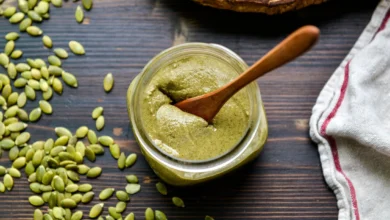The BEST Lemon Blueberry Scones Recipe
My scone love affair didn’t exactly have the most romantic beginning. It started with a dry, crumbly, triangle of a pastry that was clearly meant to be dipped in a hot beverage to be even remotely palatable. It tasted more like flavored cardboard than anything remotely appetizing.
Contents
- Lemon Blueberry Scones
- Lemon Blueberry Scones Recipe
- Ingredients
- Directions
- Notes
- A Gluten-Free Delight: Lemon Blueberry Scones for All
- Creative Twists on a Classic
- Serving Up Scone Perfection
- The Secret Weapon: Frozen Grated Butter
- Tips for Scone Success
- How to Store Your Scone Creations
- What is the Secret to Making Good Scones?
- Lemon Blueberry Scones with Sour Cream
- Troubleshooting for Scone Perfection:
- Can I use buttermilk instead of half and half in lemon blueberry scones?
- Frequently Asked Questions
Lemon Blueberry Scones
But, in the interest of full disclosure – and since you’re reading this, I’m guessing you also have a scone soft spot – I’m here to tell you that not all scones are created equal. With the right recipe, a scone can easily compete with muffins, quick breads, and cinnamon rolls as the most delicious breakfast pastries of them all.
Mastering the Scone: Beyond the Basics
Having experimented with countless scone recipes, I’ve stumbled upon a master recipe where the ingredients can change with the desired flavor, but the process remains the same. It’s a careful formula that has led me to create not only these lemon blueberry scones but also incredible chocolate chip scones, blueberry scones, pumpkin scones, and many more.
This recipe promises the BEST flavor and texture, yielding scones that are crumbly yet moist and packed with juicy blueberries and a sweet-tart lemon flavor. The lemon icing adds an extra layer of sweetness, making these perfect for brunch, tea parties, bridal showers, Mother’s Day, Father’s Day, and so much more.
READ: Bacon Cheddar Chive Scones
Why These Scones Are a Cut Above the Rest:
- Bursting with flavor: Each bite offers a delightful harmony of sweet and tangy, thanks to the juicy blueberries and vibrant lemon zest.
- Perfectly textured: The edges are pleasingly crumbly, while the interior is tender and moist—a textural symphony in every scone.
- Golden brown perfection: The tops boast a beautiful golden crust, adding a subtle crunch to each bite.
- Lemon lover’s dream: The luscious lemon icing adds an extra layer of bright, zesty sweetness.
- Irresistible all around: These scones are the whole package—flavorful, tender, and visually stunning.
Nutritional Information
| Nutrient | Amount |
|---|---|
| Calories | 504kcal |
| Carbohydrates | 84g |
| Protein | 6g |
| Fat | 17g |
| Saturated Fat | 10g |
| Polyunsaturated Fat | 1g |
| Monounsaturated Fat | 4g |
| Trans Fat | 1g |
| Cholesterol | 46mg |
| Sodium | 217mg |
| Potassium | 327mg |
| Fiber | 2g |
| Sugar | 48g |
| Vitamin A | 518IU |
| Vitamin C | 3mg |
| Calcium | 144mg |
| Iron | 2mg |
Lemon Blueberry Scones Recipe
Course: BreakfastCuisine: American8
scones20
minutes22
minutes504
kcal42
minutesThese tender, lemony scones are bursting with juicy blueberries and topped with a sweet lemon glaze. Perfect for a special breakfast or afternoon treat.
Ingredients
Blueberries: 1 cup, fresh or frozen (if frozen, thawed and drained)
All-purpose flour: 2 cups, spooned and leveled
Baking powder: 2 teaspoons
Granulated sugar: 1/4 cup, plus more for sprinkling
Kosher salt: 1/2 teaspoon
Unsalted butter: 8 tablespoons (1 stick), frozen and grated
Half and half: 2/3 cup (or whole milk if that’s what you have on hand—yes, you can absolutely make delicious lemon blueberry scones without heavy cream!)
Egg: 1 large
Vanilla extract: 1 teaspoon
Lemon zest: 1 tablespoon, finely grated
Lemon juice: 2 tablespoons (for the glaze)
Powdered sugar: 1 cup (for the glaze)
Directions
- Prep the dry: In a large bowl, whisk together the flour, sugar, baking powder, salt, and lemon zest.
- Cut in the butter: Cut the cold butter into the dry ingredients using a pastry cutter, two forks, your fingertips, or even a food processor. Be careful not to overwork the dough, as this will develop the gluten in the flour and lead to tough scones. You want to achieve a crumbly mixture with pea-sized pieces of butter remaining.
- Mix the wet: In a separate bowl, whisk together the half and half (or milk), egg, and vanilla extract.
- Combine and conquer: Make a well in the center of the dry ingredients and pour in the wet ingredients. Add the blueberries and gently fold everything together until just combined. Be careful not to overmix! If using frozen berries, there’s no need to thaw them first.
- Shape and chill: Turn the dough out onto a lightly floured surface and gently form it into a 1-inch thick disc. Cut the disc into 8 wedges.
- Get ready to bake: Arrange the scones on a baking sheet lined with parchment paper. For an extra special touch and a bakery-style crunch, brush the tops with a little heavy cream and sprinkle with coarse sugar.
- Bake to perfection: Bake the scones in a preheated oven until golden brown. The result will be scones with a flaky center, a crumbly exterior, and a burst of lemon-blueberry goodness in every bite.
- Pro tip: For the best flavor and texture, chill the shaped scones for at least 15 minutes before baking. You can even refrigerate them overnight for a quick and easy breakfast the next morning.
Notes
- For the fluffiest scones, grate the butter while it’s frozen.
- Don’t overmix the dough – a few streaks of flour are okay.
- Chilling the dough for at least 15 minutes before baking helps prevent spreading and promotes flakiness.
- Leftover scones can be stored in an airtight container at room temperature for up to 2 days or frozen for up to 2 months.
A Gluten-Free Delight: Lemon Blueberry Scones for All
No need to miss out on the scone fun if you’re gluten-free! Simply swap out the all-purpose flour in the master recipe for a high-quality gluten-free 1:1 baking flour blend. Look for a blend that includes xanthan gum, as this helps mimic the texture and binding properties of gluten. The rest of the recipe remains the same, and you’ll be rewarded with tender, flavorful gluten-free lemon blueberry scones that rival their traditional counterparts.
READ: Can You Freeze Scones
Creative Twists on a Classic
Don’t be afraid to get creative with your scones! Add a teaspoon of freshly grated ginger to the dry ingredients for a warm, spicy kick that pairs beautifully with the lemon and blueberry. If you’re not a blueberry fan, substitute an equal amount of raspberries or blackberries for a different flavor profile. For an extra decadent touch, drizzle a simple white chocolate glaze (made with melted white chocolate and a bit of coconut oil) over the lemon icing. The possibilities are endless!
And for those who are gluten-free, don’t worry! You can still enjoy these delightful scones by simply swapping out the all-purpose flour for a high-quality gluten-free flour blend. Look for a blend that measures 1:1 with regular flour and be sure to follow the instructions on the package for best results. You may need to slightly adjust the amount of liquid in the recipe to achieve the perfect scone dough consistency.
Serving Up Scone Perfection
Elevate your scone experience with these delectable pairings:
- Classic Cream Tea: Embrace tradition with a dollop of clotted cream and a spoonful of your favorite jam—lemon curd is especially delightful with these lemon blueberry scones.
- Whipped Cream Dream: For an extra touch of indulgence, crown your scone with a cloud of freshly whipped cream.
- Fresh and Fruity: Enhance the summery vibes with a side of mixed berries or a vibrant fruit salad. The sweetness and acidity of the fruit complement the rich flavors of the scone.
- Vegan Variations: For a dairy-free delight, try a dollop of coconut whipped cream or a smear of vegan butter and your favorite fruit preserves.
The Secret Weapon: Frozen Grated Butter
Frozen grated butter is the key to scone success, just like it is for pie crust. When the cold butter hits the hot oven, the tiny pieces of butter melt and release steam, which creates the signature scone flakiness we all love. The exterior becomes crumbly, crunchy, and crisp, while the interior stays soft and moist.
Using refrigerated butter that is cut into small cubes will still melt in the dough in the oven, but the finer pieces from grated frozen butter melt quicker and result in less spread, leading to taller scones. You can grate the butter with a box grater, but I find it’s easier if you freeze the butter first.
As for the lemon icing, it’s a simple mixture of sifted confectioners’ sugar, lemon juice, and a touch of half-n-half. It’s sinfully sweet, tangy, and seeps into the tops of these summer-y treats. But, if lemon isn’t your thing, there are plenty of other ways to top these scones. A classic vanilla icing or a dollop of lemon curd are also fabulous topping choices.
READ: Apple and White Chocolate Scones
Tips for Scone Success
- Measure flour accurately: Use the spoon and sweep method (spoon flour into the measuring cup and then sweep off the excess) to avoid dense scones. Scooping directly from the bag will pack in too much flour.
- Chill out: Keep all refrigerated items well chilled, especially the butter. Cold ingredients are essential for tender, flaky scones.
- Smaller is better: Cut the butter into tiny cubes or grate it. Large cubes or slices won’t distribute as evenly throughout the dough.
- Don’t be skimpy: Avoid using thin liquids like water or fat-free milk. Half-n-half or cream will yield the best results.
- Handle with care: Don’t overwork the dough. Too much kneading or handling will develop the gluten and result in a tough, rock-hard scone.
How to Store Your Scone Creations
These blueberry scones will last at room temperature for about a day. If refrigerated in an airtight container, they’ll keep for up to 3 days.
To freeze your baked scones, make sure they cool completely before topping with icing. Place them in a freezer-safe bag or container and they’ll keep for up to 2 months. Thaw them overnight in the refrigerator or warm them in the microwave for about 20 seconds. You can also place them on a baking sheet and tent with foil in a 325 °F (160 °C) oven for 5-10 minutes. Cool and then top with icing.
If you want to make the dough ahead of time, form the scones, cover, and place in the refrigerator the night before baking.
What is the Secret to Making Good Scones?
The secret lies in a combination of factors:
- Resist the twist: When cutting the scones, use a sharp knife and press straight down. Avoid twisting the knife, as this can seal the edges and prevent the scones from rising properly.
- Use frozen butter: As discussed earlier, frozen grated butter is a game-changer for scone texture.
- Don’t overwork the dough: Mix until just combined to avoid developing the gluten in the flour, which will lead to tough scones.
- Freeze the dough: Chilling the dough for at least 15 minutes before baking allows the butter to firm up, resulting in flakier scones.
- Create rise and shine: Brush the tops with heavy cream and sprinkle with coarse sugar for a beautiful golden crust.
- Follow this recipe: This recipe has been tested and perfected to yield the best possible scones. Trust the process!
- Reduce the juice: If using frozen blueberries, be sure to thaw and drain them well to avoid excess liquid in the dough.
- Fresh is best: Whenever possible, opt for fresh ingredients for the most vibrant flavors.
Lemon Blueberry Scones with Sour Cream
For an extra layer of richness and tang, you can swap out the half and half for sour cream in this recipe. The result? Lemon blueberry scones with sour cream that are even more tender and moist, with a subtle tang that perfectly complements the sweetness of the berries and lemon glaze. Simply use the same amount of sour cream (2/3 cup) as you would half and half in the recipe.
Troubleshooting for Scone Perfection:
Even with the best recipe, a few missteps can lead to scone disappointment. Here’s how to troubleshoot common issues:
- Dense or tough scones: This is usually a sign of overmixing. Remember, less is more when it comes to scone dough. Mix until just combined, even if there are a few streaks of flour remaining.
- Flat or crumbly scones: Warm butter is the culprit here. Make sure your butter is well chilled and cut into small pieces or grated before mixing it into the dry ingredients.
- Pale or underbaked scones: Your oven might not be hot enough. Double-check your oven temperature with an oven thermometer to ensure accuracy.
- Dry scones: If your scones are too dry, you may have over-measured the flour or not used enough liquid. Make sure to spoon and level the flour, and use whole milk or even a bit of extra cream if needed.
Can I use buttermilk instead of half and half in lemon blueberry scones?
Absolutely! Buttermilk is a fantastic alternative to half and half, adding a subtle tanginess that complements the lemon and blueberries beautifully. If you’re using buttermilk, you’ll likely need to adjust the amount of liquid slightly. Start with a little less than the recipe calls for and add more as needed until the dough comes together.
Conclusion
There you have it – a tried-and-true recipe for lemon blueberry scones that will elevate any occasion. Whether you’re enjoying them warm from the oven on a lazy weekend morning or sharing them with friends at a festive gathering, these scones are sure to impress.
So, don your apron, gather your ingredients, and embark on a baking adventure that will leave your kitchen smelling heavenly and your taste buds singing.
__________________________________________
Frequently Asked Questions
Can I make these lemon blueberry scones vegan?
Absolutely! You can easily adapt this recipe to be vegan by using a plant-based butter substitute, your favorite non-dairy milk instead of half-and-half, and a flax egg (1 tablespoon ground flaxseed mixed with 3 tablespoons water) in place of the egg. The resulting vegan lemon blueberry scones will be just as delicious and satisfying.
Can you use milk instead of heavy cream in scones?
Yes, you can! The magic ratio is that 1 cup (227g) of heavy cream can be replaced by 1/2 cup (113g) of butter and 1/2 cup (118ml) of milk.
What is the most suitable type of flour to use when making fruit scones?
While muffins, scones, biscuits, cookies, and fruit bread all use creaming methods, different flours work best for each. AP flour or bread flour have too much gluten and will make a dense, less tender scone.
Cake flour doesn’t have enough gluten to hold the structure. Pastry flour will work, but it can be hard to find and is more expensive. All-purpose flour is the most flexible and least expensive option for making scones.
How do you keep scones soft?
Buttermilk is a great way to keep scones ultra-tender. Freezing the scones before baking ensures the butter is cold, which creates airy pockets within the scone. Adding an egg also creates a rich, soft scone, but you don’t need the full amount of liquid if using an egg.





